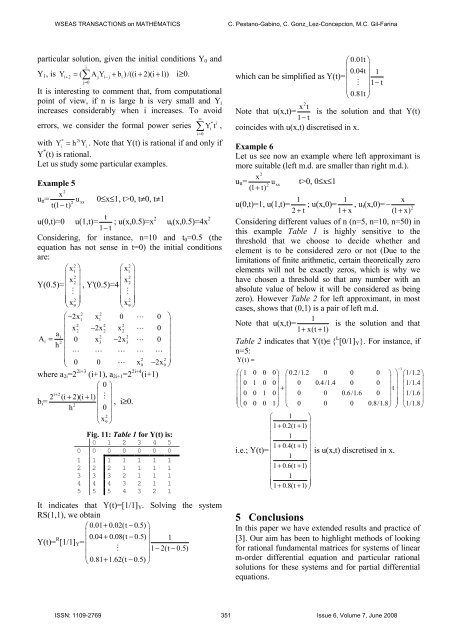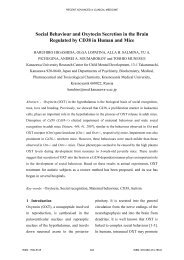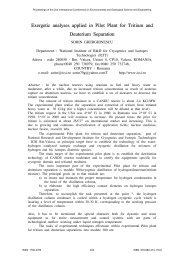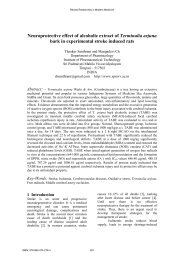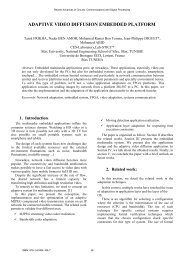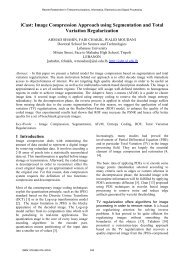The Matrix Padé Approximation in Systems of Differential ... - WSEAS
The Matrix Padé Approximation in Systems of Differential ... - WSEAS
The Matrix Padé Approximation in Systems of Differential ... - WSEAS
Create successful ePaper yourself
Turn your PDF publications into a flip-book with our unique Google optimized e-Paper software.
<strong>WSEAS</strong> TRANSACTIONS on MATHEMATICSC. Pestano-Gab<strong>in</strong>o, C. Gonz_Lez-Concepcion, M.C. Gil-Far<strong>in</strong>aparticular solution, given the <strong>in</strong>itial conditions Y 0 andiY 1 , is Yi+ 2= ( ∑ AjYi − j+ bi) /((i + 2)(i + 1)) i≥0.j=0It is <strong>in</strong>terest<strong>in</strong>g to comment that, from computationalpo<strong>in</strong>t <strong>of</strong> view, if n is large h is very small and Y i<strong>in</strong>creases considerably when i <strong>in</strong>creases. To avoiderrors, we consider the formal power series∞* i∑ Yit ,i=0* 2iwith Yi= h Yi. Note that Y(t) is rational if and only ifY * (t) is rational.Let us study some particular examples.Example 52xu tt = u2t(1 − t)xx0≤x≤1, t>0, t≠0, t≠1u(0,t)=0 u(1,t)= t1− t; u(x,0.5)=x2 u t (x,0.5)=4x 2Consider<strong>in</strong>g, for <strong>in</strong>stance, n=10 and t 0 =0.5 (theequation has not sense <strong>in</strong> t=0) the <strong>in</strong>itial conditionsare:22⎛ x ⎞⎛1x ⎞1⎜ 2 ⎟⎜ 2 ⎟x2Y(0.5)= ⎜ ⎟ , Y'(0.5)=4 ⎜ x2⎟⎜ ⋮ ⎟⎜ ⋮ ⎟⎜2x ⎟⎜2⎝ 9 ⎠x ⎟⎝ 9 ⎠⎛ −2x x 0 ⋯ 02 21 1⎜ 2 2 22 2 2a⎜ −i 2 2i= ⎜23−3x 2x x ⋯ 0A 0 x 2x ⋯ 0h ⎜⎜ ⋯ ⋯ ⋯ ⋯ ⋯⎜⎝ 0 0 ⋯ x −2xwhere a 2i =2 2i+3 (i+1), a 2i+1 =2 2i+4 (i+1)⎛ 0 ⎞b i = i +⎜ ⎟2 2 (i + 2)(i + 1) ⎜⋮ ⎟ , i≥0.2h ⎜ 0 ⎟⎜ 2 ⎟⎝ x9⎠2 29 9⎞⎟⎟⎟⎟⎟⎟⎠Fig. 11: Table 1 for Y(t) is:0 1 2 3 4 50 0 0 0 0 0 01 1 1 1 1 1 12 2 2 1 1 1 13 3 3 2 1 1 14 4 4 3 2 1 15 5 5 4 3 2 1It <strong>in</strong>dicates that Y(t)=[1/1] Y . Solv<strong>in</strong>g the systemRS(1,1), we obta<strong>in</strong>⎛ 0.01+ 0.02(t − 0.5) ⎞⎜⎟Y(t)= R 0.04 0.08(t 0.5) 1[1/1] Y = ⎜+ −⎟⎜ ⋮ ⎟1− 2(t − 0.5)⎜⎟⎝ 0.81+ 1.62(t − 0.5) ⎠⎛ 0.01t ⎞⎜ ⎟0.04t 1which can be simplified as Y(t)= ⎜ ⎟⎜ ⋮ ⎟1−t⎜ ⎟⎝ 0.81t ⎠xNote that u(x,t)= 2 tis the solution and that Y(t)1−tco<strong>in</strong>cides with u(x,t) discretised <strong>in</strong> x.Example 6Let us see now an example where left approximant ismore suitable (left m.d. are smaller than right m.d.).2xu tt = u2 xxt>0, 0≤x≤1(1 + t)u(0,t)=1, u(1,t)= 12 + t; u(x,0)= 11+ x, u xt(x,0)= −2(1 + x)Consider<strong>in</strong>g different values <strong>of</strong> n (n=5, n=10, n=50) <strong>in</strong>this example Table 1 is highly sensitive to thethreshold that we choose to decide whether andelement is to be considered zero or not (Due to thelimitations <strong>of</strong> f<strong>in</strong>ite arithmetic, certa<strong>in</strong> theoretically zeroelements will not be exactly zeros, which is why wehave chosen a threshold so that any number with anabsolute value <strong>of</strong> below it will be considered as be<strong>in</strong>gzero). However Table 2 for left approximant, <strong>in</strong> mostcases, shows that (0,1) is a pair <strong>of</strong> left m.d.1Note that u(x,t)= is the solution and that1+ x(t + 1)Table 2 <strong>in</strong>dicates that Y(t)∈{ L [0/1] Y }. For <strong>in</strong>stance, ifn=5:Y(t) =⎛⎛1 0 0 0⎞ ⎛0.2 /1.2 0 0 0 ⎞ ⎞ ⎛1/1.2⎞⎜⎜ ⎟ ⎜ ⎟ ⎟ ⎜ ⎟⎜⎜ 0 1 0 0⎟0 0.4/1.4 0 0 1/1.4+ ⎜ ⎟ t⎟ ⎜ ⎟⎜⎜0 0 1 0⎟ ⎜ 0 0 0.6/1.6 0 ⎟ ⎟ ⎜1/1.6⎟⎜⎜ ⎟ ⎜ ⎟ ⎜ ⎟0 0 0 1 0 0 0 0.8/1.8 ⎟⎝⎝ ⎠ ⎝ ⎠ ⎠ ⎝1/1.8⎠i.e.; Y(t)=⎛ 1 ⎞⎜1 0.2(t 1)⎟⎜+ +⎟⎜ 1 ⎟⎜⎟⎜1+ 0.4(t + 1) ⎟⎜ 1 ⎟⎜⎟⎜1+ 0.6(t + 1) ⎟⎜ 1 ⎟⎜1+ 0.8(t + 1) ⎟⎝⎠is u(x,t) discretised <strong>in</strong> x.5 ConclusionsIn this paper we have extended results and practice <strong>of</strong>[3]. Our aim has been to highlight methods <strong>of</strong> look<strong>in</strong>gfor rational fundamental matrices for systems <strong>of</strong> l<strong>in</strong>earm-order differential equation and particular rationalsolutions for these systems and for partial differentialequations.−1ISSN: 1109-2769 351 Issue 6, Volume 7, June 2008


